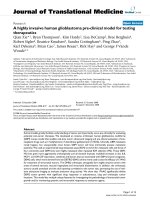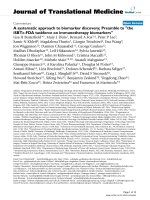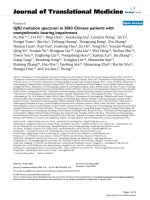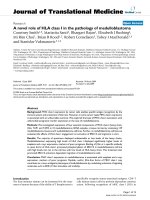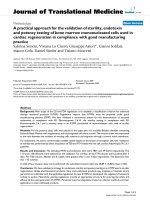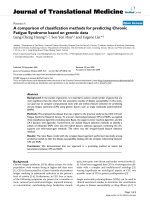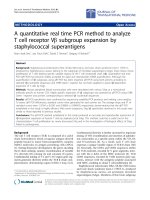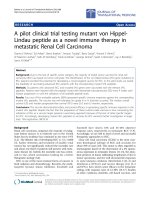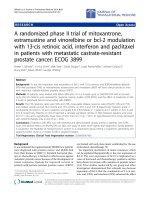Báo cáo hóa học: " A broad spectrum, one-step reverse-transcription PCR amplification of the neuraminidase gene from multiple subtypes of influenza A virus" pdf
Bạn đang xem bản rút gọn của tài liệu. Xem và tải ngay bản đầy đủ của tài liệu tại đây (870.98 KB, 11 trang )
BioMed Central
Page 1 of 11
(page number not for citation purposes)
Virology Journal
Open Access
Research
A broad spectrum, one-step reverse-transcription PCR
amplification of the neuraminidase gene from multiple subtypes of
influenza A virus
Alejandra Castillo Alvarez
1
, Marion EG Brunck
1
, Victoria Boyd
2
, Richard Lai
1
,
Elena Virtue
2,3
, Wenbin Chen
4
, Cheryl Bletchly
4
, Hans G Heine
2
and
Ross Barnard*
1,5
Address:
1
Biochip Innovations Pty Ltd., 8 Mile Plains, Queensland, Australia,
2
CSIRO livestock Industries, Australian Animal Health Laboratory
(AAHL), Geelong, Vic, Australia,
3
Australian Biosecurity Cooperative Research Centre for Emerging Infectious Disease, The University of
Queensland, St. Lucia, Queensland, Australia,
4
Pathology Queensland, Central Laboratory, Herston Hospitals Campus, Herston, Queensland,
Australia and
5
School of Molecular and Microbial Sciences, The University of Queensland, St. Lucia, Queensland, Australia
Email: Alejandra Castillo Alvarez - ; Marion EG Brunck - ;
Victoria Boyd - ; Richard Lai - ; Elena Virtue - ;
Wenbin Chen - ; Cheryl Bletchly - ; Hans G Heine - ;
Ross Barnard* -
* Corresponding author
Abstract
Background: The emergence of high pathogenicity strains of Influenza A virus in a variety of
human and animal hosts, with wide geographic distribution, has highlighted the importance of rapid
identification and subtyping of the virus for outbreak management and treatment. Type A virus can
be classified into subtypes according to the viral envelope glycoproteins, hemagglutinin and
neuraminidase. Here we review the existing specificity and amplification of published primers to
subtype neuraminidase genes and describe a new broad spectrum primer pair that can detect all 9
neuraminidase subtypes.
Results: Bioinformatic analysis of 3,337 full-length influenza A neuraminidase segments in the
NCBI database revealed semi-conserved regions not previously targeted by primers. Two
degenerate primers with M13 tags, NA8F-M13 and NA10R-M13 were designed from these regions
and used to generate a 253 bp cDNA product. One-step RT-PCR testing was successful in 31/32
(97%) cases using a touchdown protocol with RNA from over 32 different cultured influenza A
virus strains representing the 9 neuraminidase subtypes. Frozen blinded clinical nasopharyngeal
aspirates were also assayed and were mostly of subtype N2. The region amplified was direct
sequenced and then used in database searches to confirm the identity of the template RNA. The
RT-PCR fragment generated includes one of the mutation sites related to oseltamivir resistance,
H274Y.
Conclusion: Our one-step RT-PCR assay followed by sequencing is a rapid, accurate, and specific
method for detection and subtyping of different neuraminidase subtypes from a range of host
species and from different geographical locations.
Published: 9 July 2008
Virology Journal 2008, 5:77 doi:10.1186/1743-422X-5-77
Received: 9 May 2008
Accepted: 9 July 2008
This article is available from: />© 2008 Alvarez et al; licensee BioMed Central Ltd.
This is an Open Access article distributed under the terms of the Creative Commons Attribution License ( />),
which permits unrestricted use, distribution, and reproduction in any medium, provided the original work is properly cited.
Virology Journal 2008, 5:77 />Page 2 of 11
(page number not for citation purposes)
Background
Influenza viruses are enveloped, segmented, negative
sense RNA viruses of the family Orthomyxoviridae and are
classified into types (A, B or C) based on the antigenic dif-
ference in their nucleoproteins (NP) and matrix proteins
(M1). Influenza virus A and B infections are an important
cause of morbidity and mortality in humans and in a wide
range of animal species [1-3]. Type "A" viruses are the
most important pathogens of the three types and have
been associated with all of the past influenza pandemics
[4,5].
Influenza A viruses are classified into subtypes according
to the hemagglutinin (HA) and neuraminidase (NA) glyc-
oproteins that are present in the viral envelope. There are
16 subtypes of HA (H1-H16) and nine subtypes of NA
(N1-N9) identified by serology [6]. Different combina-
tions of HA and NA subtypes are found in wild birds
which are the natural reservoir of influenza viruses. In
contrast, only some subtypes are commonly found in
humans. For instance, three HA subtypes and two NA sub-
types have established stable lineages in humans and have
been routinely isolated since last century (e.g. H1N1 in
1918, H2N2 in 1957, and H3N2 in 1968) [7-9]. However,
a number of viruses have reemerged over recent years and
various subtypes of influenza A virus including H5N1,
H9N2, H7N7, H7N3, and H7N2 have been reported to
infect humans [10,11]. Most importantly, recent out-
breaks of highly pathogenic H5N1 in different continents
have shown that the virus jumps the species barrier from
poultry to humans, causing high mortality in both spe-
cies, even though the virus is not easily transmitted from
humans to humans [10,12,13]. These findings reiterate
the importance of influenza virus surveillance in poultry
and humans.
In addition, the latest outbreak of influenza A in horses in
Australia also highlights the importance of animal surveil-
lance during and post outbreak. Equine influenza is con-
sidered the most economically important respiratory
disease of horses in countries with significant racing and
breeding industries, with subtype H3N8 the predominant
subtype [14].
Rapid and accurate subtyping of influenza A virus is cru-
cial for the diagnosis and surveillance of emerging viruses
and for outbreak management, as well as for determining
the appropriate treatment and presence of drug resistant
strains.
Traditionally, the gold standard for virus detection
involves virus replication in eggs or tissue culture fol-
lowed by HA inhibition [15,16] and NA inhibition assays
[17,18]. However, these inhibition assays are laborious,
not very sensitive and do not provide results in a period
that allows for optimal use of potentially effective antivi-
ral treatment [14,19,20]. To date, influenza diagnostic
methods based on reverse transcription-PCR (RT-PCR)
and real-time RT-PCR (RRT-PCR) are currently available
for HA, but they are not well developed for NA. Current
NA PCR tests only identify a few subtypes (e.g. N1-N2)
[21-23]. The only assay identifying all 9 NA subtypes is a
nested two-step RT-PCR method followed by cloning and
sequencing described by Hoffman et al.[24]. There is no
published data on how the former method behaves (ie.
sensitivity and specificity) when clinical samples are
assayed, which might represent a problem when amplify-
ing a full length NA gene (1.5 kb) in these type of samples.
The whole process for subtyping is slow and prone to con-
tamination (because it is a nested PCR), which might not
be a practical test for routine surveillance work or post-
diagnostic studies.
Therefore, there is a need for relatively simple and fast test
that provides subtype and sequence information of all
known NA subtypes, targeting a spectrum of hosts with
acceptable sensitivity. To this end, we have designed a
primer set for a one-step RT-PCR detection assay of multi-
ple influenza A viruses, based on the detection of the NA
gene. Our one-step RT-PCR method, followed by sequenc-
ing, was validated with a panel of 32 allantoic fluids con-
taining influenza A viruses, representing the 9 NA
subtypes obtained from a range of host species and from
different geographic locations. Archived clinical speci-
mens, mainly from Queensland, Australia were also
tested. Efficacy of our method was compared with the tra-
ditional neuraminidase inhibition test [17,18]. From our
findings, we concluded that this one-step RT-PCR assay
followed by sequencing is a rapid and specific method for
influenza A virus detection and NA subtyping.
Results
Design of oligonucleotides
Despite the high sequence variability of the NA gene
between subtypes of influenza "A" viruses, we used
entropy plots (data not shown) to identify semi-con-
served regions, where primers could be designed. Two tar-
get regions that potentially identify all possible NA
subtypes were chosen. Primer NA8F corresponds to the
region from base 690 to 708 and primer NA10R to the
region from base 890 to 909 (base numbering corre-
sponds to reference sequence Genbank accession number
DQ139321
). The two primers without M13 tags ampli-
fied an approximate 219 bp NA fragment which includes
one mutation site known to be related to oseltamivir
resistance (e.g. virus subtype N1: amino acid H274Y).
There are other residues that confer resistance to the NA
inhibitors, but for the purpose of this study we focused on
the H274Y mutation (an NA mutation that appears to be
Virology Journal 2008, 5:77 />Page 3 of 11
(page number not for citation purposes)
increasing significantly in frequency and distribution
[25]).
Bioinformatic analysis of each primer is presented in
sequence logo format as shown in Figures 1, 2. The NA8F
and NA10R primers were aligned against 3,337 sequences
in the NCBI IVRD. When analyzing the last five bases at
the 3'end of the primer NA8F, the alignment gave close to
100% match for all subtypes. In the case of the primer
NA10R, the alignment gave close to 100% predicted
match in the last 5 bases for all subtypes except for N2,
N4, and N5 where it was 99.40%, 77% and 15% respec-
tively. The N2 subtype has variability in the last five bases,
but the frequency of variability is so low such that there is
only one nucleotide difference in any single mismatched
virus sequence. Despite the percentage of predicted mis-
match in the last five 3' terminal bases of N4 and N5 sub-
types they are detected with our primers. Thus, all 9 NA
subtypes can be amplified as shown in Table 2 and Figure
3.
Detection of influenza A virus by one-step RT-PCR and NA
subtyping
Freeze-thawed blinded clinical NPA (see "clinical sam-
ples", later revealed to consist of a mix of influenza A,
influenza B and adenovirus) were assayed by our one-step
RT-PCR using NA8F/NA10R primers followed by indirect
sequencing. Our clinical data showed amplification of the
expected 219 bp NA fragment from 25/37 (68%) of freeze
stored influenza A samples and these were mostly N2 sub-
type (see Table 1 and Figure 4). From these influenza A
clinical NPAs samples, two of them labeled as #17 and #
31 in Table 1 were initially amplified by our primers but
did not re-amplify using NA M13 tagged primers. We
could not repeat the assay because our RNA stock of those
2 samples was exhausted. The fact that there was no virus
isolated for those samples does not necessarily explain the
lack of amplification, as we clearly amplified and sub-
typed clinical NPAs samples #3 and #21 which also had
no virus isolated.
In addition to the influenza A clinical samples tested, 30
blinded negative controls were assayed: 24/25 samples
classsifed as influenza B by a hospital pathology service
were negative and 1/25 was positive; 1/1 adenovirus sam-
ple and 4/4 RSV samples were negative. It is unclear why
the one sample labeled as influenza B was positive (clini-
cal NPA # 67), however, there was evidence of macro-
scopic contaminants in this sample (colored particulates),
leading us to question its integrity. We were unable to
reproduce the amplification of the later sample for further
sequence analysis.
In order to speed the procedure for routine post-diagnos-
tic application, M13 extensions or "tags" were added to
the primers, which, as a serendipitous benefit, reduced
non-specific banding in some of the samples previously
assayed with NA8F/NA10R primer set (data not shown).
Therefore, to validate our one-step RT-PCR method using
M13 tagged primers followed by direct sequencing, a
panel of influenza A virus strains (in allantoic fluids) rep-
resenting the 9 NA subtypes was assayed (see Table 2). In
total, 31/32 (97%) were amplified and the subtyping
results were compared with the traditional neuraminidase
inhibition assay. The identity of the 253 bp fragments was
confirmed by direct sequence analysis and BLAST search
(see Table 2). The sample that did not amplify was influ-
enza A/Gull/Maryland/704/77/H13N6 (Fig. 3, lanes 5
and 11); however the other H13N6 sample influenza/A/
Gull/Tas/06 (not shown) did amplify, as did the other
eight N6 subtypes including A/Mallard/Gurjev/244/82
(Figure 3, lane 12). It is unclear why the amplification of
one N6 sample failed, because none of the N6 subtype full
length sequences from the IVRD database (n = 119),
including the ones for that particular H13N6 (Genbank
accession numbers AY207553
and CY014696), have
destabilizing mutations in the primer annealing sites.
Sensitivity of the one-step RT-PCR assay
Ten-fold serial dilutions of in-vitro transcribed N1, N7 and
N8 cultured RNA sample were prepared from 1 × 10
12
to
1.8 × 10
0
copy number. For each of the virus subtypes
tested, PCR products were visualized by Ethidium Bro-
mide staining on a 1.5% w/v agarose gel (see Figure 5). In
testing of dilutions of in-vitro transcribed RNA a band of
approximately 253 bp was clearly visible with 40 femto-
gram of starting RNA for N1 and N7 subtypes using 36
cycles. For cultured virus a band of the expected size was
visible in the range 10
3
(H5N1, 43 cycles) to 10
4
(H3N8,
36 cycles) copies. In all cases where bands were visible in
agarose gel there was sufficient material for direct
sequencing.
Discussion
Several strategies of RT-PCR have been used to type and
subtype influenza A viruses based on different gene seg-
ments, such as the Matrix gene [19,26-28], HA gene
[5,12,21,28,29], and a few using NA gene [5,21,23,24].
The assays available for the NA gene segment employ sub-
type-specific primers, which require a number of different,
or nested [24] reactions to determine each subtype and
may not cover all of the 9 NA subtypes. We are the first to
design a primer set for a one-step RT-PCR assay of multi-
ple influenza A viruses that can amplify all 9 NA subtypes
simultaneously from a range of host species and from dif-
ferent geographical locations. In our hands, the primers
we have designed produced cleaner bands than those
obtained using primers described in [24], when applied to
similar samples (cultured virus).
Virology Journal 2008, 5:77 />Page 4 of 11
(page number not for citation purposes)
An advantage of subtyping influenza A virus by RT-PCR
followed by sequencing is the saving of time. The tradi-
tional approach for NA subtyping is through NA inhibi-
tion assay, sometimes followed by confirmatory PCR for
inconclusive results. The NA inhibition assay requires
viral culture, and subtyping is obtained within 1–2 weeks.
We circumvent this by going directly from extraction of
viral RNA from the sample, performing a one-step RT-PCR
assay, followed by sequencing and BLAST analysis, thus
shortening the time to 2–3 days for NA subtyping.
Nucleotide sequence alignment of NA8F primerFigure 1
Nucleotide sequence alignment of NA8F primer. A sequence logo representation of 3,337 available sequences in the
NCBI database at the time the study was conducted. All 9 NA subtypes were aligned against the NA8F primer and analyzed for
discrepancies at the 3'end. The big letters represent the consensus sequences for each subtype. The standard mixed base defi-
nition was applied, and for reference "I" stands for inosine.
a
Alignment is presented in sequence logo format [32-34].
NA
Subtype
No. sequences
analyzed/No.
sequences in
DB
Nucleotide sequence alignment of NA8F in 5’-3’
a
% sequences matched identical
at all five 3’ terminal bases
N1 975/975
99.90%
position 18, 0.1% sequences have C
N2 2018/2018
99.95%
position 15, 0.05% sequence have A
N3 98/98
100%
N4 13/13
100%
N5 26/26
100%
N6 72/72
100%
N7 28/28
100%
N8 80/80
85%
position 17, 13.75% sequences have C,
1.25% sequences have T
N9 27/27
100%
Total 3, 337/3,337
99.58%
Virology Journal 2008, 5:77 />Page 5 of 11
(page number not for citation purposes)
Another advantage of subtyping the virus by RT-PCR is
that sequence analysis of the PCR product, in addition to
allowing accurate NA subtyping, could provide important
epidemiological information on the origin of the identi-
fied influenza virus. This information cannot be provided
by NA inhibition assay. In addition, the fragment gener-
ated through our RT-PCR can be interrogated for the pres-
ence of one of the mutations conferring resistance to
oseltamivir, which is crucial for initiating an appropriate
treatment and management of outbreaks.
Nucleotide sequence alignment of NA10R primerFigure 2
Nucleotide sequence alignment of NA10R primer. A sequence logo representation of 3,337 available sequences in the
NCBI database at the time the study was conducted. All 9 NA subtypes were aligned against the NA10R primer and analyzed
for discrepancies at the 3'end. The big letters represent the general consensus sequences for each subtype and at the end a
general consensus sequence is given for the total population of samples. The standard mixed base definition was applied, and
for reference "I" stands for inosine.
a
Alignment is presented in sequence logo format [32-34].
NA
Subtype
No. sequences
analyzed/No.
sequences in
DB
Nucleotide sequence alignment of NA10R in 5’-3’
a
% samples matched identical
at all 5 3’ ter minal bases
N1 975/975
99.59%
position 17, 0.41% sequences have G
N2 2018/2018
99.40%
position 16, 0.05% sequences have T;
position 17, 0.15% sequences have G;
position 19, 0.30% sequences have T;
position 20, 0.05% sequences have G
N3 98/98
100%
N4 13/13
77%
position 17, 23% sequences have G
N5 26/26
15%
position 17, 85% sequences have G
N6 72/72
100%
N7 28/28
100%
N8 80/80
100%
N9 27/27
100%
Total 3,337/3,337
98.77%
Virology Journal 2008, 5:77 />Page 6 of 11
(page number not for citation purposes)
There was one discrepancy between NA types obtained by
neuraminidase inhibition test and our one step RT-PCR.
Of the four putative N1 samples (three cultured viruses
and one clinical sample), typed by Neuraminidase inhibi-
tion test, three were confirmed as N1 by our method, but
one (the clinical sample) was typed as N2 by our assay.
Additional N1 clinical samples will be tested to confirm if
there is a systematic misclassification by the neuramini-
dase inhibition test. In three samples, high quality
sequence was not obtainable from the amplified prod-
ucts. One of these samples had visible discoloration
which could indicate the presence of compounds that
may interfere with the sequencing process. One of the
panels of N6 viruses (H13N6) failed to amplify. The Gen-
Table 1: Identification of neuraminidase subtypes of influenza A clinical nasopharyngeal aspirates.
Sample
No. *
HA
subtype
a
NA
subtype
Subtype Amplification by
our RT-PCR sequence
1H3NVI
1
H3 - -
2 H3 N2 H3N2 Wisconsin/67/2005 like strain + N2
3H3NVI
1
, N/A
2
H3 + N2
5 H3 N2 H3N2 Wisconsin/67/2005 like strain + -
6 H3 N2 H3N2 Wisconsin/67/2005 like strain + N2
8H3 N2 H3N2 + N2
9H3NVI
1
, N/A
2
H3 - -
10 H3 N2 H3N2 + N2
12
e
H1 N1 H1N1 + N2
14 H3 N2 H3N2 Wisconsin/67/2005 like strain - -
15 H3 N2 H3N2 Wisconsin/67/2005 like strain + N2
17 H3 NVI
1
, N/A
2
H3 + NSA
3
19 H3 N2 H3N2 Wisconsin/67/2005 like strain + N2
21 H3 NVI
1
, N/A
2
H3 + N2
26 H3 N2 H3N2 Wisconsin/67/2005 like strain - -
27 H3 NVI
1
H3 - -
30 H3 N2 H3N2 Wisconsin/67/2005 like strain + N2
31 H3 NVI
1
H3 + NSA
3
32 H3 N2 H3N2 Wisconsin/67/2005 like strain + N2
33 H3 N2 H3N2 Wisconsin/67/2005 like strain + N2
34 H3 N2 H3N2 Wisconsin/67/2005 like strain + N2
36 H3 NVI
1
H3 - -
37 H3 N2 H3N2 Wisconsin/67/2005 like strain + N2
38 H3 N2 H3N2 Wisconsin/67/2005 like strain + N2
42 H3 N2 H3N2 Wisconsin/67/2005 like strain + N2
45 H3 N2 H3N2 Wisconsin/67/2005 like strain + N2
47 H3 NVI
1
, N/A
2
H3 - -
50 H3 NVI
1
, N/A
2
H3 - -
51 H3 N2 H3N2 Wisconsin/67/2005 like strain + N2
54 H3 N2 H3N2 Wisconsin/67/2005 like strain + N2
55 H3 N2 H3N2 Wisconsin/67/2005 like strain + N2
56 H3 NVI
1
, N/A
2
H3 - -
57
c
NVI
1
NVI
1
, N/A
2
Not available - -
62
d
H5 N/A
2
H5 + N2
63
d
H5 N/A
2
N/A
2
64
d
Not H5 N/A
2
N/A
2
65 H3 N2 H3N2 Wisconsin/67/2005 like strain + N2
67
f
-N/A
2
Not available + NSA
3
*Blinded specimens provided by Pathology Queensland. Only typed A influenza samples were listed. Type B influenza samples, adenovirus, and RSV
samples were not included as they were all negative by our assay.
a
HA subtyping was performed by Queensland Forensic and Scientific Services using real-time PCR based on HA specific primers, as well as by
hemaglutination and inhibition test to the viruses that were able to be cultured.
c
Sample 57 was not confirmed by a second laboratory for Influenza A infection nor was there virus isolated.
d
Samples 62, 63 and 64 are not clinical samples but are positive control RNA sample from WHO reference lab.
e
Sample was assayed and subtyped in duplicate to corroborate the NA subtype by sequence.
f
Sample 67 had pink contaminants floating in the RNA that could have affected PCR result.
NVI
1
= No virus isolated, therefore NA subtyping was unfeasible.
N/A
2
= Sample was not assayed with the corresponding test.
NSA
3
= RT-PCR was positive but we were not able to obtain subtype by direct sequencing.
Virology Journal 2008, 5:77 />Page 7 of 11
(page number not for citation purposes)
bank entry for that particular virus does not show muta-
tions in the primer annealing site, so the failure to amplify
is not likely to result from sequence drift on the primer
site. Nine other viruses of subtype N6 were successfully
amplified.
When interpreting clinical NPA amplification results, the
percentage obtained (68%) provides support that our
assay is likely to be suitable for use for clinical samples.
RNA quality was an issue because the clinical samples
used, had been stored for a year at -80°C, and freeze-
thawed twice prior to running our assay. RNA extracted
from fresh clinical samples will be sought in order to
determine the positive and negative agreement with other
diagnostic methods at multiple testing sites.
Conclusion
Our data indicates that, compared to Neuraminidase inhi-
bition testing and other RT-PCRs, the newly designed one-
step RT-PCR assay offers a faster, accurate and specific tool
for the subtyping all 9 NA subtypes of influenza A viruses
from a range of Mammalian and Avian species. The
sequence information obtained can be helpful in deter-
mining the origin of the influenza virus and can be inter-
rogated for the presence of mutations conferring
resistance to antiviral drugs. The prompt availability of
this information is important for initiating an appropriate
treatment and for the tracing and management of out-
breaks.
Methods
Design of oligonucleotides
Neuraminidase (NA) primers design
NA RT-PCR primers were designed based on sequence
information obtained from the NCBI Influenza Virus
Resource Database (IVRD) [30]. A selection of 1,101 full-
length NA sequences of the 9 subtypes, of a range of host
species and from different geographical locations were
retrieved and aligned using Biological Sequence Align-
ment editor software (BioEdit, version 7.09, CA, US) [31].
A tabular summary of the nucleotide composition at each
position in the alignment was used for the primer design
and the strategy was as follows: all positions in the target
region had a GAP ≤ 5 (GAP is the number of viruses for
which information is lacking regarding nucleotide com-
position at a particular position of a nucleic acid align-
ment), and semi-conserved sequence regions of 20
nucleotides long with a redundancy ≤ 195 were sought.
Redundancy was then minimized by inserting inosines at
more than 1 site.
Bioinformatic analysis of designed NA8F/NA10R primers
NA8F and NA10R primers were aligned against the 3,337
sequences retrieved from the IVRD at the time of analysis.
The sequence alignment is presented in sequence logo for-
mat [32-34]. The percentage of samples with identical
matches at all five 3' terminal bases was calculated for
each NA subtype.
Samples and RNA extraction
Animal samples from allantoic fluids
Virus (see Table 2) from the reference collection at the
Australian Animal Health Laboratory (AAHL) was grown
in embryonated eggs. Samples included Influenza virus A
from ducks (n = 9), chickens (n = 6), shearwater (n = 3),
gull (n = 3), emu (n = 1), other avian species (n = 7),
equine (n = 1) and others (n = 2). Viral RNA was extracted
from 100 μL of amniotic fluid sample inactivated by addi-
One-step RT-PCR amplification of NA gene from clinical NPA samplesFigure 4
One-step RT-PCR amplification of NA gene from
clinical NPA samples. Example of amplification results of
Influenza A and influenza B. Sample numbers correspond to
the samples described in Table 1, except sample 35 which is
influenza B (description data not shown); M, 100 bp DNA
Hyperladder II (Bioline); and negative control (- ctrl: water
instead of template).
One-step RT-PCR amplification of NA gene from all 9 NA subtypes using animal samples from allantoic fluidsFigure 3
One-step RT-PCR amplification of NA gene from all
9 NA subtypes using animal samples from allantoic
fluids. A fragment of approximately 253 bp was amplified
using primers containing M13 sequence. Example of some
subtypes (refer to Table 2 for strain names) assayed: M, 100
bp DNA Ladder (Promega); 1) H9N2, 2) H16N3, 3) H8N4,
4) H14N5, 5) H13N6, 6) H10N7, 7) H11N9, 8) H5N1, 9)
negative control (water instead of template), 10) H6N5, 11)
H13N6, 12) H14N6, 13) H7N7, 14) H3N8, 15) H11N9, 16)
negative control (water instead of template).
Virology Journal 2008, 5:77 />Page 8 of 11
(page number not for citation purposes)
tion of 600 μL of RLT buffer (guanidium denaturant) and
6 μL of 2-mercaptoethanol prior to extraction with the
QIAGEN RNeasy extraction kit (QIAGEN, Doncaster, Vic-
toria, Australia). Extraction was undertaken as per manu-
facturer's instructions. RNA was resuspended in 50 μL of
nuclease-free water.
Clinical specimens
Sixty-three frozen viral RNA extracts from clinical
nasopharyngeal aspirate (NPA) specimens were provided
as blinded specimens by the Molecular Diagnostic Unit of
Pathology Queensland Herston Hospital Campus,
Queensland (QLD), Australia, as blind specimens. The
samples had been stored at -80°C for one year and
thawed twice prior to our study. These specimens, prima-
rily isolated in QLD, were collected from suspect cases of
viral respiratory disease between September-October
2006. Patients ranged from 7 weeks to 84 years old with a
gender ratio of 58.5% for males and 41.5% females. The
blind samples encompass a selection of influenza A
viruses, influenza B viruses, and adenovirus (n = 37 influ-
enza A, n = 25 influenza B, n = 1 adenovirus). Viral RNA
was extracted from 200 μL of NPA samples using MagNA
Pure LC total nucleic acid isolation kit (Roche) and eluted
in 100 μL of elution buffer as per manufacturer's protocol.
Freshly extracted RNA was initially used by Pathology
Table 2: Identification of all neuraminidase subtypes by RT-PCR followed by direct sequencing using animal samples from allantoic
fluids.
Influenza virus strain (
a
) Subtype (
b
) One-step RT-
PCR (
c
)
NA subtype by
sequence (
d,e
)
1) A/Chicken/Vietnam/8/04 H5N1 + N1
2) A/Chicken/Laos/26/06 H5N1 + (8) N1
3) A/Chicken/Cambodia/1A/04 H5N1 + N1
4) A/Chicken/Malacca/4905/03 H9N2 + (1) N2
5) A/Gull/Denmark/68110/02 H16N3 + (2) N3
6) A/Shearwater/Aust/75 H5N3 + N3
7) A/Grey teal/WA/1762/79 H4N4 + N4
8) A/Emu/NSW/97 H7N4 + N4
9) A/Turkey/Ontario/6118/67 H8N4 + (3) N4
10) A/Shearwater/Aust/72 H6N5 + (10) N5
11) A/Mallard/Gurjev/263/82 H14N5 + (4) N5
12) A/Mallard/Gurjev/244/82 H14N6 + (12) N6
13) A/Gull/Maryland/704/77 H13N6 Neg (5, 11) Not typed
14) A/Gull/Tas/06 H13N6 + N6
15) A/Duck/NZ/89 H4N6 + N6
16) A/Grey teal/WA/1855 H4N6 + N6
17) A/Duck/Viet/317/2005 H4N6 + N6
18) A/Duck/Viet/318/2005 H4N6 + N6
19) A/Duck/Viet/323/2005 H4N6 + N6
20) A/Duck/Viet/342/2005 H3N6 + N6
21) A/Duck/Vic/512/2007 H7N6 + N6
22) A/Duck/Victoria/1/76 H7N7 + (13) N7
23) A/Chicken/Germany/N/49 H10N7 + (6) N7
24) A/Chicken/Victoria/1/85(
f
)H7N7+N7
25) A/N. Korean H7N7 + N7
26) A/Avian/669/WA/78 H3N8 + (14) N8
27) A/Equine/Sydney/2888-8/2007 H3/N8 + N8
28) A/Tern/Aust/75 H11N9 + (7, 15) N9
29) A/Shelduck/WA/1757/78(
f
)H1N9+N9
30) A/Red-necked stint/WA/5745/84(
f
) H12N9 + N9
31) A/Shelduck/WA/1762/79 H15N9 + N9
32) A/Wedge tailed shearwater/WA/2327/1983 H15N9 + N9
(
a
) Strains from the collection at the Australian Animal Health Laboratory were kindly provided by Paul Selleck. RNA was extracted from allantoic
fluid.
(
b
) Subtypes of virus stock were determined previously at AAHL by HA and NA inhibition assays according to Barr and O'Rourke [38], Van Dusen,
et al. [18]and Aymard-Henry, et al. [17].
(
c
) RT-PCR fragment visualized in agarose gel electrophoresis. In brackets refer to lane numbers on agarose gel, Figure 3; not all results shown on
gel)
(
d
) Sequencing directly from gel purified one-step RT-PCR using M13 tagged primers.
(
e
) Results of Blastn analysis.
(
f
) These samples were assayed by two-step RT-PCR before transferring to one-step RT-PCR.
Virology Journal 2008, 5:77 />Page 9 of 11
(page number not for citation purposes)
Queensland to perform sample typing (influenza A/influ-
enza B) using real-time RT-PCR based on the matrix gene
specific primers according to Syrmis, et al. [27].
In addition, four frozen respiratory syncytial viral RNA
(RSV) extracts from clinical NPA specimens were tested.
The clinical specimens were from reported cases of viral
respiratory disease from Sydney in the period of
2003–2004. Viral RNA was extracted from these samples
using High Pure Viral Nucleic Acid kit (Roche) as per
manufacturer's protocol.
Previous data (not shown) suggested that RSV clinical
RNA samples had genomic DNA contaminants. There-
fore, 5 μL of RSV RNA were treated with RNase-Free
DNase (Promega) as per manufacturer's protocol, prior to
one-step RT-PCR.
One step-reverse transcription-PCR (RT-PCR)
One-step RT-PCR was performed in 50 μL reaction vol-
ume using SuperScript™ III One-Step RT-PCR System with
Platinum
®
Taq DNA polymerase kit (Invitrogen, Carlsbad,
CA, USA) as per manufacturer's protocol with the follow-
ing modifications: 4 μmoles/L of each primer (or 1
μmoles/L of each primer for cultured samples) NA8F-M13
5'-GTA AAA CGA CGG CCA GT GRA CHC ARG ART CIK
MRTG-3'- and NA10R-M13 5'-CAG GAA ACA GCT ATG
AC CCI IKC CAR TTR TCY CTR CA-3' or NA8F 5'-GRA
CHC ARG ART CIK MRTG-3' and NA10R 5'-CCI IKC CAR
TTR TCY CTR CA-3' and 1 to 2 μL of RNA were added.
Thermocycling was performed with the following cycling
conditions: 30 min at 46°C and 10 min at 60°C (reverse
transcription), 3 min at 94°C (initial denaturation), 8
cycles of step-down PCR consisting of 30 s at 94°C (dena-
turation), 30 s at 56°C (annealing) – decrease 2°C each
cycle until 42°C; and 75s at 68°C (extension). Amplifica-
tion of the final product was completed for 36 cycles of 30
s at 94°C, 30 s at 43°C, and 75 s at 68°C, with a final
extension of 10 min at 68°C for egg cultured and in-vitro
transcribed RNA samples. For RNA extracted from clinical
samples, 43 cycles were used. Reactions were performed
in Mastercycler
®
ep gradient S apparatus (Eppendorf) or
MyCycler thermal cycler (Bio-Rad). In the negative con-
trol, water for injections BP (Pfizer) or RNase free water
(Promega) was used instead of template RNA. The posi-
tive control included influenza A/N2 (clinical sample #
12) or influenza A/H3N8/Avian/669/WA/78. Amplicons
(10 μL of sample) were visualized by gel electrophoresis
on 1.5% agarose containing ethidium bromide. The size
of the amplicons generated with M13 tags was approxi-
mately 253 bp and amplicons without the M13 tags was
approximately 219 bp.
Sequencing
The 253 bp RT-PCR fragments with M13-tags were direct
sequenced as described below. For the 219 bp RT-PCR
fragments, indirect sequencing was performed.
Direct sequencing
For direct sequencing, whole reaction volumes of the 253
bp amplicon with M13 tags were loaded on 1.5% agarose
containing ethidium bromide and gel purified using
QIAquick Gel Extraction Kit (QIAGEN) as per manufac-
turer's instructions. Sequencing reactions using M13
sequencing primers were completed at AAHL or at the
Australian Genome Research Facility, AGRF [35], using an
automatic sequencer AB3730xl (Applied Biosystems, US).
Results were analyzed and influenza virus subtypes were
determined by BLAST analysis [36].
Indirect sequencing
For indirect sequencing, amplicons (10 μL of sample) of
the 219 bp one-step RT-PCR product were initially visual-
ized by gel electrophoresis on 1.5% agarose containing
ethidium bromide; and then, whole reaction volumes
were loaded and gel purified using QIAquick Gel Extrac-
tion Kit (QIAGEN) as per manufacturers' instructions. A
PCR was carried out to produce the 253 bp fragment with
M13 tags. The PCR was performed using Taq DNA
polymerase, recombinant kit (Invitrogen) with the fol-
lowing modifications: 4 μmoles/L of each primer NA8F-
M13 and NA10R-M13 were used, and 6 ng of gel-cleaned
cDNA was used as template. Thermocycling was per-
formed with the following cycling conditions: 3 min at
94°C (initial denaturation), 8 cycles of step-down PCR
consisting of 30 s at 94°C (denaturation), 30 s at 56°C
then decrease 2°C each cycle until 42°C; 75s at 68°C
(extension), followed by 30 cycles of 30 s at 94°C, 30 s at
43°C, 75 s at 72°C, with a final extension of 10 min at
72°C. Reactions were performed in Mastercycler
®
ep gradi-
ent S apparatus (Eppendorf). In the negative control,
water for injection BP (Pfizer) was used instead of tem-
plate RNA. Positive controls included influenza A (N2)
Sensitivity of the one-step RT-PCR assayFigure 5
Sensitivity of the one-step RT-PCR assay. Example of
amplification results of ten-fold serial dilutions of in-vitro tran-
scribed RNA H10N7 subtype (refer to Table 2 for strain
name). A band of approximately 253 bp was clearly visible
with 40 femtogram of starting RNA (equivalent to 10
5
cop-
ies). M, 100 bp DNA Hyperladder II (Bioline); and negative
control (- ctrl: water instead of template).
Virology Journal 2008, 5:77 />Page 10 of 11
(page number not for citation purposes)
(samples # 65, 8 or 12). Amplicons (10 μL of sample)
were visualized by gel electrophoresis on 1.5% agarose
containing ethidium bromide. Sequencing was performed
the same way as described for the direct sequencing
method. Results were analyzed and influenza virus sub-
types were determined by BLAST analysis [36].
Sensitivity of the one-step RT-PCR assay
To determine the analytical sensitivity of the one-step RT-
PCR using NA8F-M13 and NA10R-M13 primers, ten-fold
serial dilutions of in-vitro transcribed RNA of the NA frag-
ment amplified by our primers of egg-cultured sample A/
Chicken/Cambodia/1A/04/H5N1 (shown in Table 2)
were made down to 10 copies/μL transcribed RNA. The
concentration of the transcribed RNA (ng/μL) was quanti-
fied using the Nanodrop
®
ND-1000 UV-Vis spectropho-
tometer (Nanodrop Technologies). Conversion of ng/μL
of single stranded RNA to pmol/μL was performed using
the following mathematical formula: pmol/μL = ng/μL
(of ssRNA) × (1 μg/1000 ng) × (10
6
pg/1 μg) × (1 pmol/
340 pg) × (1/N); where N = 324 bp, the number of bases
of the RNA transcript, and 340 pg/pmol is the average
molecular weight of a ribonucleotide. The copy number/
μL transcribed RNA was calculated as follows: copy
number/μL RNA transcript = (RNA in mol/μL) ×
(Avogrado constant, 6.023 × 10
23
molecules/mol) [37].
Two μL of undiluted RNA stock was used as a positive con-
trol, and two μL of each serial dilution was used for the
one-step RT-PCR. Amplicons (10 μL/sample) were visual-
ized by gel electrophoresis on 1.5% agarose containing
ethidium bromide.
Abbreviations
AAHL: Australian animal health laboratory; AGRF: Aus-
tralian genome research facility; bp: Base pair; GAP:
Number of occurrences which lack nucleotide informa-
tion at a determined position of a nucleic acid alignment;
HA: Hemagglutinin; IVRD: Influenza virus resource data-
base; M1: Matrix protein; NA: Neuraminidase; N/A: Sam-
ple was not assayed with the corresponding test; NCBI:
National center for biotechnology information; NP:
Nucleoprotein; NPA: Nasopharyngeal aspirate; NSA: RT-
PCR positive but no subtype available; NVI: No virus iso-
lated; PCR: Polymerase chain reaction; QLD: Queensland;
RLT buffer: RNeasy lysis buffer provided by QIAGEN;
RSV: Respiratory syncytial virus; RT-PCR: Reverse tran-
scription PCR; RRT-PCR: Real time reverse transcription
PCR.
Competing interests
The authors VB, EV, WC, CB, and HGH declare that they
have no competing interests. ACA, and RL are receiving
salary from Biochip Innovations Pty Ltd. MEGB received
salary from Biochip Innovations Pty Ltd. RB holds shares
in Biochip Innovations Pty Ltd. ACA, RL, and RB are
inventors on patent # WO/2008/000023 held by BioChip
Innovations Pty Ltd that relates to the content of the man-
uscript. BioChip Innovations Pty Ltd is financing the
processing charge of this manuscript.
Authors' contributions
ACA designed the primers and participated in the design
of the study with assistance from RB, planned and per-
formed the experiments at University of Queensland and
drafted the manuscript. MEGB participated in sensitivity
assays and edited the manuscript. VB performed experi-
ments to evaluate the one-step RT-PCR assay for N subtyp-
ing on cultured virus samples and contributed to editing
the manuscript. RL participated in the extraction of RNA
and edited the manuscript along with EV, WC, and CB. EV
was also involved with virus culture, RNA extraction and
RT-PCR validation. WC and CB provided clinical samples,
results of neuraminidase inhibition assays and haemag-
glutinin subtyping and real-time PCR for influenza A/B.
HGH instigated the evaluation of the one-step RT-PCR
assay and sequencing for N subtyping of influenza at
AAHL, helped to draft and edit the manuscript, and par-
ticipated in the overview of the study. RB conceived of the
study, and participated in its design and coordination,
helped to draft the manuscript, and participated actively
in the overview of the study. All authors read and
approved the final manuscript.
Acknowledgements
We thank Paul Selleck, AAHL, for providing virus stocks and information.
We thank Associate Professor Theo Sloots and Dr. David Whiley, of the
Clinical Virology Research Unit, Sir Albert Sakzewski Virus Research Cen-
tre, Royal Children's Hospital and Health Service District, QLD, Australia
for providing blinded clinical samples. We thank Prof. Adrian Gibbs for
helping with the early planning of the project. We thank Gautier Robin for
critically reading the manuscript.
This work was funded by BioChip Innovations Pty Ltd, the Australian Biose-
curity Cooperative Research Centre for Emerging Disease and the CSIRO
Livestock Industries – Australian Animal Health Laboratory.
References
1. Gavin PJ, Thomson RB: Review of rapid diagnostic tests for
influenza. Clinical and Applied Immunology Reviews 2004, 4:151-172.
2. Olsen B, Munster VJ, Wallensten A, Waldenstrom J, Osterhaus AD,
Fouchier RA: Global patterns of influenza a virus in wild birds.
Science 2006, 312:384-388.
3. Zhang WD, Evans DH: Detection and identification of human
influenza viruses by the polymerase chain reaction. J Virol
Methods 1991, 33:165-189.
4. Horimoto T, Kawaoka Y: Pandemic threat posed by avian influ-
enza A viruses. Clin Microbiol Rev 2001, 14:129-149.
5. Payungporn S, Chutinimitkul S, Chaisingh A, Damrongwantanapokin
S, Buranathai C, Amonsin A, Theamboonlers A, Poovorawan Y: Sin-
gle step multiplex real-time RT-PCR for H5N1 influenza A
virus detection. J Virol Methods 2006, 131:143-147.
6. Fouchier RA, Munster V, Wallensten A, Bestebroer TM, Herfst S,
Smith D, Rimmelzwaan GF, Olsen B, Osterhaus AD: Characteriza-
tion of a novel influenza A virus hemagglutinin subtype
(H16) obtained from black-headed gulls. J Virol 2005,
79:2814-2822.
Publish with BioMed Central and every
scientist can read your work free of charge
"BioMed Central will be the most significant development for
disseminating the results of biomedical research in our lifetime."
Sir Paul Nurse, Cancer Research UK
Your research papers will be:
available free of charge to the entire biomedical community
peer reviewed and published immediately upon acceptance
cited in PubMed and archived on PubMed Central
yours — you keep the copyright
Submit your manuscript here:
/>BioMedcentral
Virology Journal 2008, 5:77 />Page 11 of 11
(page number not for citation purposes)
7. Gamblin SJ, Haire LF, Russell RJ, Stevens DJ, Xiao B, Ha Y, Vasisht N,
Steinhauer DA, Daniels RS, Elliot A, et al.: The structure and
receptor binding properties of the 1918 influenza hemagglu-
tinin. Science 2004, 303:1838-1842.
8. Li OT, Barr I, Leung CY, Chen H, Guan Y, Peiris JS, Poon LL: Reliable
universal RT-PCR assays for studying influenza polymerase
subunit gene sequences from all 16 haemagglutinin sub-
types. J Virol Methods 2007, 142:218-222.
9. Russell RJ, Haire LF, Stevens DJ, Collins PJ, Lin YP, Blackburn GM, Hay
AJ, Gamblin SJ, Skehel JJ: The structure of H5N1 avian influenza
neuraminidase suggests new opportunities for drug design.
Nature 2006, 443:45-49.
10. Trampuz A, Prabhu RM, Smith TF, Baddour LM: Avian influenza: a
new pandemic threat? Mayo Clin Proc 2004, 79:523-530. quiz 530
11. World Health Organization: Avian Influenza [http://
www.who.int/en/]
12. Lee MS, Chang PC, Shien JH, Cheng MC, Shieh HK: Identification
and subtyping of avian influenza viruses by reverse transcrip-
tion-PCR. J Virol Methods 2001, 97:13-22.
13. World Health Organization: Avian Influenza, H5N1 avian
influenza: Timeline of major events 11 sep 2007 [http://
www.who.int/csr/disease/avian_influenza/ai_timeline/en/index.html]
14. Quinlivan M, Dempsey E, Ryan F, Arkins S, Cullinane A: Real-time
reverse transcription PCR for detection and quantitative
analysis of equine influenza virus. J Clin Microbiol 2005,
43:5055-5057.
15. Allan WH, Gough RE: A standard haemagglutination inhibition
test for Newcastle disease. (1). A comparison of macro and
micro methods. Vet Rec 1974, 95:120-123.
16. Palmer DF, Dowdle WR, Coleman MT, Schild GC: Advanced labo-
ratory techniques for influenza diagnosis. Immunology Series No
6 (US Department of Health Education and Welfare/US Public Health Serv-
ice, Washington DC) 1975, 1:.
17. Aymard-Henry M, Coleman MT, Dowdle WR, Laver WG, Schild GC,
Webster RG: Influenzavirus neuraminidase and neuramini-
dase-inhibition test procedures. Bull World Health Organization
1973, 48:199-202.
18. Van Deusen RA, Hinshaw VS, Senne DA, Pellacani D: Micro neu-
raminidase-inhibition assay for classification of influenza A
virus neuraminidases. Avian Dis 1983, 27:745-750.
19. Carraro E, Neto DF, Benfica D, SittaPerosa AH, Granato CF, Bellei
NC: Applications of a duplex reverse transcription polymer-
ase chain reaction and direct immunofluorescence assay in
comparison with virus isolation for detection of influenza A
and B. Diagn Microbiol Infect Dis 2007, 57:53-57.
20. Dawson ED, Moore CL, Smagala JA, Dankbar DM, Mehlmann M,
Townsend MB, Smith CB, Cox NJ, Kuchta RD, Rowlen KL: MChip:
a tool for influenza surveillance. Anal Chem 2006, 78:7610-7615.
21. Poddar SK: Influenza virus types and subtypes detection by
single step single tube multiplex reverse transcription-
polymerase chain reaction (RT-PCR) and agarose gel elec-
trophoresis. J Virol Methods 2002, 99:63-70.
22. Stockton J, Ellis JS, Saville M, Clewley JP, Zambon MC: Multiplex
PCR for typing and subtyping influenza and respiratory syn-
cytial viruses. J Clin Microbiol 1998, 36:2990-2995.
23. Takao S, Shimazu Y, Fukuda S, Kuwayama M, Miyazaki K: Neurami-
nidase subtyping of human influenza a viruses by RT-PCR
and its application to clinical isolates. Jpn J Infect Dis 2002,
55:204-205.
24. Hoffmann E, Stech J, Guan Y, Webster RG, Perez DR: Universal
primer set for the full-length amplification of all influenza A
viruses. Arch Virol 2001, 146:2275-2289.
25. World health organization: Influenza A (H1N1) virus resist-
ance to oseltamivir – last quarter 2007 to 4 April 2008 [http:/
/www.who.int/csr/disease/influenza/h1n1_table/en/index.html]
26. Fouchier RAM, Bestebroer TM, Herfst S, Kemp L van der, Rim-
melzwaan GF, Osterhaus A: Detection of influenza A viruses
from different species by PCR amplification of conserved
sequences in the matrix gene. J Clin Microbiol 2000,
38:4096-4101.
27. Syrmis MW, Whiley DM, Thomas M, Mackay IM, Williamson J, Siebert
DJ, Nissen MD, Sloots TP: A sensitive, specific, and cost-effec-
tive multiplex reverse transcriptase-PCR assay for the
detection of seven common respiratory viruses in respira-
tory samples. J Mol Diagn 2004, 6:125-131.
28. van Elden LJR, Nijhuis M, Schipper P, Schuurman R, van Loon AM:
Simultaneous detection of influenza viruses A and B using
real-time quantitative PCR. J Clin Microbiol 2001, 39:196-200.
29. Chaharaein B, Omar AR, Aini I, Yusoff K, Hassan SS: Detection of
H5, H7 and H9 subtypes of avian influenza viruses by multi-
plex reverse transcription-polymerase chain reaction. Micro-
biol Res 2007.
30. National center for biotechnology information: Influenza
virus resource database (IVRD) [ />genomes/FLU/]
31. Biological sequence alignment editor for Win95/98/n2/2K/
XP (BioEdit) [ />]
32. Crooks GE, Hon G, Chandonia JM, Brenner SE: WebLogo: a
sequence logo generator. Genome Res 2004, 14:1188-1190.
33. Schneider TD, Stephens RM: Sequence logos: a new way to dis-
play consensus sequences. Nucleic Acids Res 1990, 18:6097-6100.
34. Shaner MC, Blair IM, Schneider TD: Sequence logos: a powerful,
yet simple tool. In Proceedings of the Twenty-Sixth Annual Hawaii
International Conference on System Sciences. Architecture and Biotechnol-
ogy Computing Volume 1. Edited by: Mudge TN, Milutinovic V, Hunter
L. Los Alamitos, CA: IEEE Computer Society Press; 1993:813-821.
35. Australian Genome Research Facility [ />]
36. Altschul SF, Madden TL, Schaffer AA, Zhang J, Zhang Z, Miller W, Lip-
man DJ: Gapped BLAST and PSI-BLAST: a new generation of
protein database search programs. Nucleic Acids Res 1997,
25:3389-3402.
37. Olmos A, Bertolini E, Gil M, Cambra M: Real-time assay for quan-
titative detection of non-persistently transmitted Plum pox
virus RNA targets in single aphids. J Virol Methods 2005,
128:151-155.
38. Barr DA, O'Rourke MD: Virulent avian influenza. Australian
Standard Diagnostic Techniques for Animal Disease 2005, 51:. CSIRO,
East Melbourne
